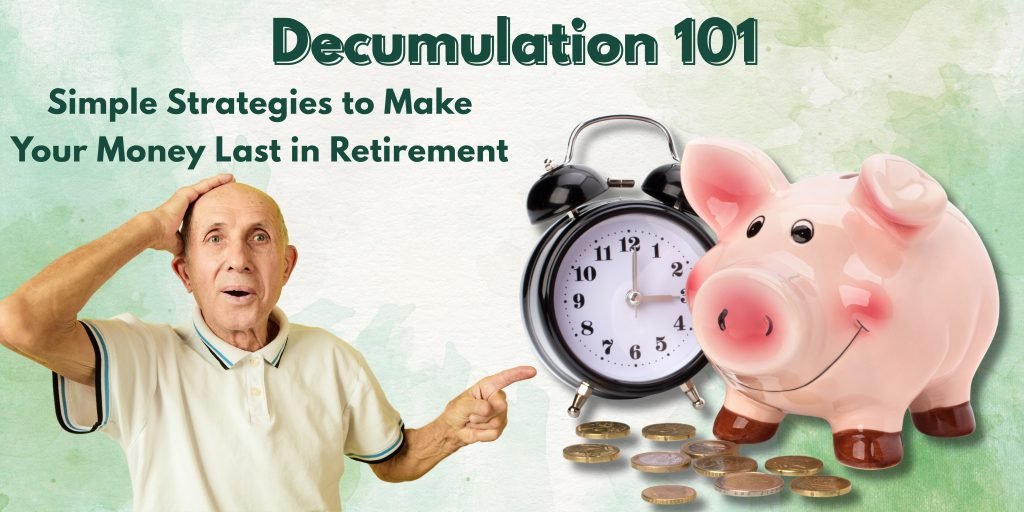Decumulation 101: Simple Strategies to Make Your Money Last in Retirement

Last Updated on August 26, 2025 by Rose Ann
Saving for retirement is like climbing a mountain. It takes years of steady effort, discipline, and determination to reach the top. But here’s the surprising part: the climb down is often trickier than the climb up.
That “climb down” is called decumulation, the stage of life when you begin to spend the savings you worked so hard to build. And just like descending a mountain, it requires balance, planning, and careful steps to avoid a dangerous slip.
The number one fear many retirees share isn’t boredom or even healthcare — it’s running out of money too soon. The good news? With the right withdrawal strategy and an understanding of risks like the sequence of returns, you can spend with confidence and make your money last.
This guide will break it all down simply, no finance degree required.
What is Decumulation?
Decumulation is the phase of retirement where you turn your savings into a steady, sustainable paycheck. If the accumulation phase was about growing your nest egg, decumulation is about using it wisely — so your money lasts as long as you do.
Think of retirement as a two-part journey. First, you build the mountain (accumulation). Then, you climb down safely (decumulation). The “climb down” takes planning, pacing, and a clear route.

Why decumulation matters now more than ever?
People are living longer. A modern retirement can last 20, 30, even 40 years. That longevity is a gift, but it also creates new risks. Withdraw too quickly and you could run out. Withdraw too cautiously and you may underspend, sacrificing comfort, health, and joy you could have afforded.
Decumulation is the art of balancing three goals at once: stable income, preserving purchasing power, and making your money last.
The Core Goals of Decumulation
- Provide a reliable monthly “paycheck.” The goal is predictable income to cover essentials like housing, food, insurance, and healthcare.
- Maintain purchasing power. Inflation quietly erodes value. A plan should help your income keep up with rising prices.
- Manage risk and sequence-of-returns. Early retirement market downturns can shorten a portfolio’s life if not handled carefully.
- Optimize taxes. The order and location of withdrawals can significantly affect how long your money lasts.
- Keep flexibility. Life changes. Your spending and withdrawals should be adaptable, not rigid.
In practice, decumulation coordinates several moving parts so you get one smooth paycheck:
- Social Security and pensions provide a base income “floor.”
- Withdrawals from investment accounts fill the gap between your income floor and your spending needs.
- Taxes are managed by choosing which accounts to tap and when.
- Your investments are rebalanced periodically to stay aligned with your risk level.
- Cash reserves are used to avoid selling investments at a bad time.
With the right setup, most retirees can “set” a monthly transfer to checking and live on it like a salary.

The Building Blocks of Retirement Income
Your “retirement paycheck” usually blends five components. Understanding how each works makes later decisions easier.
- Social Security
- A lifetime, inflation-adjusted benefit. Claiming age — from 62 up to 70 — greatly affects the monthly amount. Delaying adds roughly 8 percent per year beyond full retirement age.
- Pensions and annuities
- Guaranteed payments, often for life. They act like a second Social Security and lower pressure on your investment accounts.
- Tax-deferred accounts (Traditional IRA/401(k))
- Contributions were pretax; withdrawals are taxed as ordinary income. Required Minimum Distributions (RMDs) begin at a set age (currently 73 for many retirees).
- Roth accounts
- Contributions were post-tax. Withdrawals are usually tax-free. Roth money shines late in life, when other income and RMDs have pushed you into higher brackets.
- Taxable brokerage
- Offers flexibility and long-term capital-gains treatment. Often, the first pot retirees tap because every dollar withdrawn does not fully add to taxable income.
- Other sources — part-time work, rental income, health-savings accounts for medical costs, cash-value life-insurance loans — can add variety, but the five above do the heavy lifting for most households.
Mapping Your Spending Needs
Income decisions come easier after you know your costs. A common approach is to group expenses into three buckets:
- Essentials (must-haves): housing, food, utilities, insurance premiums, property taxes, basic transportation, routine healthcare.
- Lifestyle (want-to-haves): travel, dining out, hobbies, clubs, gifts, entertainment, charitable giving.
- Legacy/large goals (nice-to-haves): college help for grandkids, major home remodels, new car, dream vacations, leaving a bequest.
Retirees rarely spend a constant amount forever. Many experience “go-go, slow-go, no-go” phases: energetic travel the first 5–10 years, quieter hobbies mid-retirement, and higher medical costs in later years. A good decumulation plan anticipates these shifts and stays flexible.
The Main Risks You Must Manage
Decumulation is not only math. Markets move, health changes, taxes shift, and emotions run high. Five risks matter most:
- Longevity risk
- You live longer than you or the averages predicted. Longevity is a blessing—but forces your money to last.
- Sequence-of-returns risk
- Big market losses in the first years of retirement can cripple a portfolio because you are withdrawing as values fall.
- Inflation risk
- Rising prices quietly erode buying power. Even low inflation halves purchasing power in about 23 years.
- Health-care risk
- Out-of-pocket medical or long-term-care costs can spike unexpectedly.
- Behavioral risk
- Fear or overconfidence may tempt you to abandon a plan: selling low when markets dip, or overspending when markets soar.
A solid plan builds buffers, rules, and diversification so none of these surprises pushes you off track.

Popular Decumulation Frameworks
When it comes to spending down your savings in retirement, there’s no one-size-fits-all playbook. Over the years, financial experts have developed several decumulation frameworks to help retirees balance steady income, growth, and protection against running out of money.
Let’s explore the most popular approaches and how they work.
Safe Withdrawal Rate (SWR)
One of the most common questions in retirement is: “How much can I safely withdraw each year without running out?” That’s where the idea of a Safe Withdrawal Rate (SWR) comes in. It’s a guideline for how much you can take from your retirement savings annually, while giving your money the best chance of lasting for the rest of your life.
Start by taking a fixed percentage (often 3.5–4 percent) of your portfolio in year one. Increase the dollar figure by inflation each year. Simple, hands-off, history suggests reasonable success over 30-year periods — yet it does not flex with markets.
The Famous “4% Rule”
The most well-known version of SWR is the 4% rule. Here’s how it works:
- In your first year of retirement, withdraw 4% of your total savings.
- In each year after, adjust that amount for inflation.
Example:
If you retire with $500,000:
- Year 1: withdraw $20,000 (4%).
- If inflation is 3% the next year, you’d withdraw $20,600 in Year 2, and so on.
This simple method was based on historical market research, and for many retirees, it worked well in giving income for 30 years or more.
Pros & Cons of the 4% Rule
✅ Pros:
- Simple and easy to follow.
- Provides a starting point for planning.
⚠️ Cons:
- Doesn’t adjust if markets fall sharply early on.
- May be too cautious for some retirees, too risky for others.
- Doesn’t account for big expenses like healthcare or helping family.
???? Think of the 4% rule like a speed limit sign: it gives you a safe number, but real-life conditions (like weather, traffic, or in this case, markets) may require you to adjust.
Guardrails (a flexible SWR)
Create an initial withdrawal (say 4 percent). Then set “rails”: if portfolio value climbs by, for example, 20 percent, give yourself a raise; if it falls 20 percent, cut spending a bit. This lets you enjoy bull markets and protect during bear markets.
- Think of this like a “raise and tighten” plan.
- You spend more when markets are strong, but tighten your belt if markets dip.
- Keeps you from overspending during downturns, while still enjoying the good years.
Bucket Strategy
Divide savings by time horizon: cash for 1–3 years of expenses, bonds for intermediate needs (4–10 years), and stocks for anything beyond. In down years you live from cash and bonds, giving stocks time to recover. Refill lower buckets after good market years.
- Divide your savings into “buckets”:
- Bucket 1 (Cash/Short-term): 1–3 years of living expenses.
- Bucket 2 (Bonds/Medium-term): 5–10 years of expenses.
- Bucket 3 (Stocks/Long-term): Growth for the future.
- In bad market years, you live from Buckets 1 & 2, giving Bucket 3 time to recover.
- Visualizing it this way makes planning much less stressful.
Cover essentials with guaranteed income — Social Security, pensions, immediate annuities—to create a “floor.” Invest the rest for growth. Knowing basics are secured lets you accept more investment risk for lifestyle goals.

Bond Tent or Buffer Assets
Hold a larger share of bonds and cash in the first decade of retirement, when sequence-of-returns risk is highest. Slowly shift back toward your long-term asset mix later. The tent acts like shock absorbers during those early, vulnerable years.
Many retirees blend systems — a bucket plan with guardrails, or a floor-and-upside mix plus a bond tent. The best choice is the one you will follow in real life.
- In the early years of retirement, hold more bonds, cash, or other safe assets.
- These “buffer” investments protect you if markets stumble early (reducing sequence-of-returns risk).
- As you age, you may gradually adjust your mix back toward more balanced investing.
Annuities or Guaranteed Income (Optional)
- For some retirees, putting part of their savings into an annuity creates a guaranteed monthly check (like a second pension).
- Provides peace of mind but reduces flexibility.
???? Pro tip: No single strategy is perfect. Many retirees combine approaches — like using a bucket system with flexible guardrails — to get both stability and freedom.
A Plain-English Example
Maria retires at 66 with:
- $600,000 in investments (50% stocks, 40% bonds, 10% cash)
- $2,200/month Social Security
- Essential expenses: $3,800/month
- Lifestyle goals: $800/month
Her income floor ($2,200) leaves a $1,600/month gap for essentials. She keeps 18 months of essentials in cash ($68,400). She adopts a 3.8% initial withdrawal rate, giving about $22,800 in year one (roughly $1,900/month before taxes), enough to cover essentials and part of lifestyle. In good market years, she grants herself a 2–3% raise; in bad years, she pauses raises and trims lifestyle spending by $100–$200/month. She rebalances each spring and uses taxable accounts first.
It’s not fancy—but it’s clear, repeatable, and resilient.
Common Mistakes to Avoid
- No cash buffer. Being forced to sell in a downturn can permanently harm portfolio longevity.
- One-size-fits-all withdrawal. Refusing to adjust in the face of high inflation or a deep bear market.
- Ignoring taxes. Triggering big unexpected tax bills or IRMAA surcharges by poor timing.
- Overconcentration. Leaning too heavily on a single stock, sector, or risky bond fund.
- Analysis paralysis. Postponing decisions indefinitely; simple beats perfect when it’s followed consistently.
Your plan should be reviewed annually and adjusted for life changes, market conditions, and health.
Sequence-of-Returns Risk (The Hidden Threat)
Here’s something many new retirees don’t see coming: the order of your investment returns can matter more than the average. This is called sequence-of-returns risk. Imagine two retirees, Mary and John.
- Both start retirement with $500,000.
- Both withdraw $20,000 per year.
- Both experience the same average market return over 20 years.
But here’s the catch:
- Mary’s portfolio has bad years early in retirement, then recovers later.
- John’s portfolio has good years early and the downturn comes much later.
Even though the average return is the same, Mary’s account runs dangerously low because she was forced to sell investments when the market was down. John, meanwhile, sees his savings last much longer.
Why Does This Happen?
When you’re withdrawing money, downturns at the start dig a much deeper hole. Your portfolio has less time (and less capital) to recover.
Think of it like hitting potholes at the beginning of a road trip: your car takes more damage when it’s still fully loaded. Hitting them near the end of the trip doesn’t hurt as much, because the car is lighter.
Key Takeaway
The good news? You don’t have to leave your retirement up to chance. There are proven ways to manage withdrawals that help balance income now with security later. Here are some of the most common approaches:
???? Pro tip: No single strategy is perfect. Many retirees combine approaches — like using a bucket system with flexible guardrails — to get both stability and freedom.

Practical Tips for Retirees
Even the best withdrawal strategy needs a little day-to-day support. Here are some practical steps to keep your plan on track:
- Keep a Cash Buffer
- Hold 1–2 years of living expenses in cash or short-term savings so you’re not forced to sell investments in a downturn.
- Review Annually
- Check your spending, portfolio balance, and withdrawal rate once a year. Small adjustments can make a big difference.
- Diversify Income Sources
- Mix Social Security, pensions, investments, and (if desired) part-time income to reduce reliance on withdrawals.
- Plan for Healthcare
- Unexpected medical bills can disrupt even the best withdrawal plan. Consider insurance, Medicare supplements, or setting aside a “health bucket.”
- Work with a Pro if Needed
- A financial advisor can stress-test your plan, especially for tax efficiency and estate planning.
Climbing Down the Mountain Safely
Retirement isn’t just about how much you’ve saved — it’s about how wisely you withdraw. Decumulation is the art of turning your nest egg into a steady income that lasts as long as you do.
By understanding tools like the safe withdrawal rate, watching out for the sequence-of-returns risk, and using strategies like guardrails, buckets, and buffer assets, you can enjoy your retirement years with confidence.
Think of it this way: you’ve already climbed the mountain. Now, with careful steps and the right strategy, you can make the descent safely — and enjoy the view along the way.
✨ How are you planning your withdrawals? Share your thoughts in the comments — your story may help others feel more secure in their retirement journey.
Frequently Asked Questions About Decumulation
1. What exactly is decumulation, and how is it different from accumulation?
Accumulation is the phase where you save and invest during your working years to grow your nest egg. Decumulation begins once you retire and start spending those savings. The key difference is that in accumulation the goal is growth, while in decumulation the goal is steady, sustainable income that lasts throughout retirement.
2. How do I know how much I can safely withdraw each year?
A common guideline is the “4% rule” — withdrawing 4% of your portfolio in the first year of retirement, then adjusting each year for inflation. But this isn’t a guarantee. The safe withdrawal rate depends on your age, lifestyle, market conditions, and other income sources. Many experts today suggest a range of 3.5%–4% for long retirements to provide a margin of safety.
3. What is “sequence-of-returns risk” and why should I care?
This is one of the most overlooked risks in retirement. If you withdraw money in the early years of retirement while the market is down, your portfolio may shrink too quickly to recover — even if long-term averages look fine. Put simply: losses early on hurt more than losses late in life. Having a cash buffer and a flexible withdrawal strategy helps protect you from this risk.
4. Should I withdraw from my IRA, Roth IRA, or taxable account first?
Order matters for taxes. A common approach is:
- Withdraw from taxable accounts first.
- Then use tax-deferred accounts (Traditional IRA/401(k)) — especially from age 73 when Required Minimum Distributions (RMDs) begin.
- Save Roth IRA withdrawals for last, since they are tax-free and can keep growing.
This order often reduces lifetime taxes, but the best strategy depends on your personal situation.
5. Do I need a financial planner for decumulation, or can I do it myself?
Some retirees manage decumulation alone with simple strategies like the 4% rule or the bucket strategy. However, because taxes, healthcare costs, and market risks add complexity, meeting with a fee-only fiduciary financial planner can be worthwhile. A professional can help you avoid costly mistakes, especially around tax efficiency and RMD planning.





